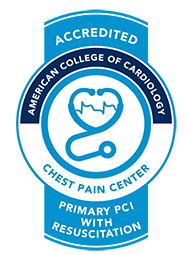
If you’re having a heart attack or a sudden cardiac arrest, a chest pain center is ideally where you want to be treated. Because everything done at a chest pain center is intentionally designed to provide the most effective and efficient assessment, diagnosis and treatment of a heart attack.
As Long Island’s only Chest Pain Center with Primary PCI & Resuscitation Accreditation, Stony Brook is a leader in saving the lives of those with cardiac emergencies. The key is getting patients treated as fast as possible, so less heart muscle is damaged. And educating the community to recognize possible heart attack symptoms – and take action – is a vital part of that.
At Stony Brook's Chest Pain Center, we have:
A trauma room just for patients with heart attack symptoms.
And if the patient has already been recognized through a pre-transmitted EKG as having a STEMI – an ST-segment elevation myocardial infarction, which is one of the most lethal and common types of heart attack – we have the Cardiac Catheterization team there waiting for them. The American College of Cardiology and the American Heart Association guidelines are to open the blockage in 90 minutes or less (called door-to-balloon time, which spans arrival at the hospital until the blockage is cleared). Stony Brook Medicine has achieved an average time of 54 minutes for calendar year 2021, well below this target.
Enabled EKG transmissions to handheld devices.
Our interventional cardiologists and fellows receive EKGs (electrocardiograms) transmitted directly from the EMS. By seeing where the elevations are, our doctors can prepare the appropriate catheters depending on which arteries appear to be blocked.
Instant EKGs in the ER.
If you walk in to the Emergency Room of Stony Brook University Hospital complaining of chest pain or heart attack symptoms, the first person you will see is an RN – not a clerk or a security guard – and the nurse will do an EKG within five minutes, before you’re even registered. The national benchmark for arrival-to-EKG is 10 minutes. Ours is significantly better – just five minutes.
A super-fast CT scanner in the ER.
In many cases, heart attacks are difficult to diagnose, but at Stony Brook, with the fast 320-slice CT scanner, we can tell if a patient has had a heart attack or not, then treat that patient immediately and appropriately. Typically, at most hospitals, if the EKG is normal, patients then have a blood test that looks for evidence of heart damage through the presence of certain enzymes. If this test is inconclusive, patients are kept at the hospital in order to repeat the blood test six hours later. If that is still inconclusive, doctors will schedule a stress test, which is done only during business hours. This may mean an overnight stay at the hospital, then more blood work. It can be a long, stressful and disruptive process.
At Stony Brook, however, after the first blood test, patients can have the CT scan. If it is negative, they can go home knowing that they did not have a heart attack. The CT scan can also reveal other conditions, such as blockages and the presence of soft plaque that hasn't yet hardened. This provides patients with information about the early signs of disease that they can then work to control.
If you suspect a heart attack, what should you do?
It’s best to call 911, rather than drive or get a ride to the hospital. There are two big reasons for this:
- Ambulances are equipped with defibrillators, which can save your life if your heart attack triggers an unstable heart rhythm.
- Most Emergency Medical Services (EMS) are equipped with 12-lead EKGs in the ambulance, which means they can transmit results to the hospital electronically en route. At Stony Brook Heart Institute, we assemble the treatment team and equipment you need before you arrive.
Learn more about early heart attack symptoms.
Find out your cardiovascular risk.
Learn hands-only CPR by watching a 60-second video. The simple steps can help save a life. Immediate CPR from someone nearby can double — even triple — their chance of survival.

